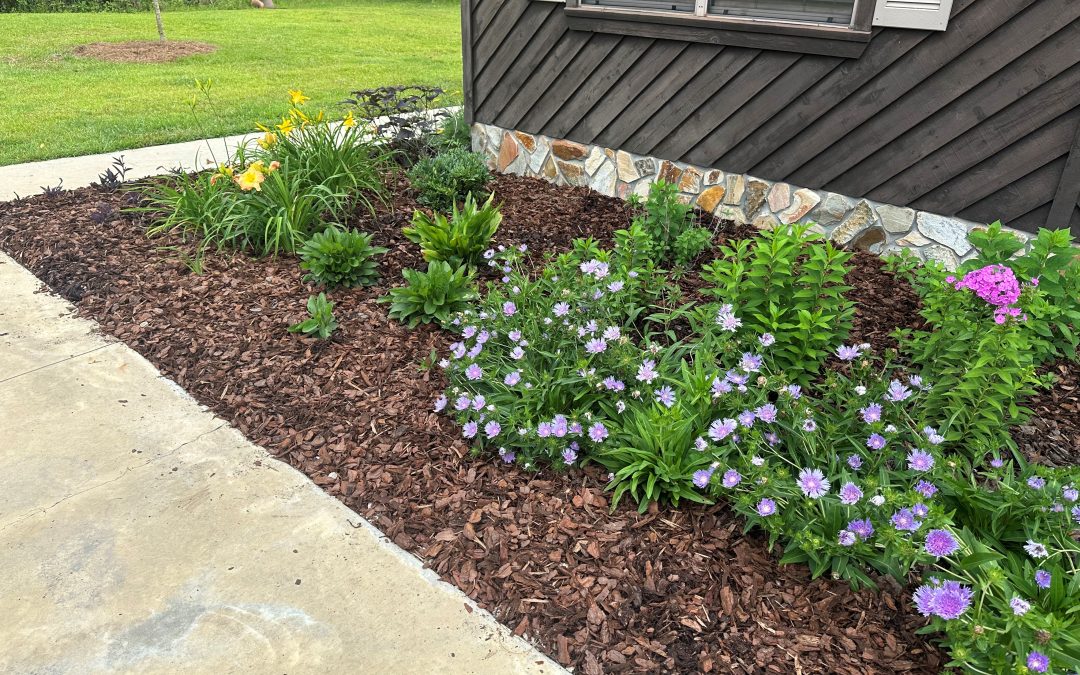
by Daniel J. Leonard | Dec 4, 2025
My previous article outlined the benefits of planting trees during the winter dormant season. Once planted, it’s then time to implement one of the best practices that helps ensure successful establishment of recently installed trees and shrubs – mulching.
Mulching, by definition, is simply the process of adding a layer of material over the top of the soil. Like planting at the right time, mulching does many great things for your landscape. Mulching helps moderate temperatures; the soil stays warmer in the winter and cooler in the summer. Mulching increases water retention; when the sun isn’t blasting directly onto the soil, it dries out much more slowly. Mulching reduces weed pressure; most weed seeds require sunlight to germinate. Etc. Etc. The benefits of mulch abound. But what material you use and how you apply mulch figure heavily into whether your mulch helps or harms the plants whose roots it lies over.
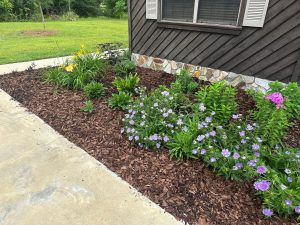
Pine bark mulch applied correctly in a landscape. Photo courtesy of Daniel Leonard.
There are two basic options when considering mulch: organic or inorganic sources. In general, you should always select an organic mulch that is derived from local sources. Organic mulches are mulches derived from natural materials like pine straw, leaves, tree bark, or shredded wood chips. These mulches break down over time and benefit soil health through bettering water holding capacity, increasing soil porosity and organic matter content, and drastically expanding the soil biome (beneficial worms, fungus, and bacteria that live in the soil). Organic mulches also allow landscapes to blend in with the natural areas surrounding homesites as they typically use materials found in local ecosystems. For example, in the coastal south, pine forests dominate, pine straw is plentiful, and purchasing usually supports local businesses that grow, harvest, and market the straw. So, unless you happen to live in a desert environment where rocks are natural, steer clear of rocks or other inorganic mulches.
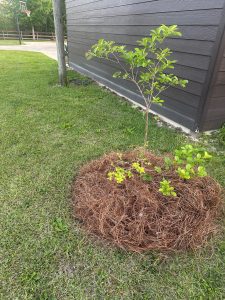
Pinestraw mulch applied around a newly planted tree. Photo courtesy of Daniel Leonard.
As with most things, there is a Goldilocks zone for mulch. Too little isn’t enough to keep weeds from easily poking through and soil from quickly drying. Too much and you risk depriving plant roots from oxygen exchange with air above, trapping too much moisture and causing rot issues, or even creating a hydrophobic layer of dried mulch that repels rainfall and irrigation. Instead, just the right amount of mulch should be applied, enough to create a 2-3” layer of helpful mulch. With some mulches like straw, this may mean applying a 6-8” layer that will settle down to the magic 2-3” number with a good rain, interlocking the individual pieces of straw. With others like wood chips or bark nuggets, there will be little settling, and the applied amount should be 2-3” deep. A final tip is to always pull mulch back a little from the crowns of plants and the trunks of woody trees and shrubs to prevent potential disease issues.
So, after you install your new landscape plants this winter, remember to mulch well. Be sure to select an organic mulch that supports local industries, enhances the soil in your landscapes, protects your plants’ roots, prevents weeds, and looks natural! For more information about mulch or any other horticultural topic, contact your local UF/IFAS County Extension Office. Happy Gardening!

by Daniel J. Leonard | Nov 26, 2025
With cold temperatures having arrived in the Panhandle last week, we’re finally getting close to prime landscape planting season. But why is winter the best time to install landscape trees and shrubs? Shouldn’t we plant when things are leafed out and growing? While it’s counterintuitive to think bitter cold, dreary days are significantly better to plant landscape plants in than the warm, sunny days of summer, it’s usually true! Let’s explore why winter is the time to plant woody trees and shrubs and then look at some of the best woody plants no Panhandle landscape should be without.
Most people from elsewhere think that Florida is always lush, green, and tropical. Those people have clearly never been to the Panhandle – heck it snowed last year! Our region of Florida has more in common, climate wise, with the rest of the south – subtropical with long hot, humid summers and wet, mild winters (though rain has been hard to come by recently), occasionally wracked by intense cold fronts. Because of those cold fronts, tropical plants cannot survive, and woody plants enter a dormant stage where above ground growth ceases. This cold-forced dormant season is the perfect time to plant woody plants because the planting process is stressful (the root system is purposefully damaged to remove circling and J-shaped roots and encourage outward growth) and regular rainfall and cool temps means conditions are right for plants to get a solid root system re-established before growth and transpiration begins in the heat of spring/summer.
Now that you know why we plant woody landscape plants when we do, let’s select a few quintessential, versatile Florida-Friendly trees and shrubs (2 each, one native and one non-native) to install in our landscapes this planting season.
Nuttall Oak (Quercus texana) is one of the most adaptable landscape trees around. The species is tolerant of many soil types, native to moist bottomland areas but tolerating drier spots well once established. While it’s a large tree – up to 70-80’ tall, I find its rounded upright habit to often be more in scale with landscapes than the wide spreading Live Oak (Quercus virginiana). Nuttall Oak certainly has many positive attributes (tough, wind-resistant, pollinator friendly, etc), but its fall color is probably my favorite. For the Panhandle it is quite good, delivering autumnal hues of red and orange.
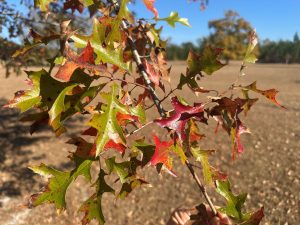
It’s not North Carolina Sugar Maple color but Nuttall Oak possesses attractive foliage. Photo courtesy of Daniel Leonard.
Crape Myrtle (Lagerstroemia indica) is the most widely grown landscape tree in the South for good reason! They’re tough, widely adapted, offer excellent summertime flower displays, and possess interesting architecture and unique bark. The primary consideration with Crape Myrtle is simply picking the right one. Do you need an upright, compact tree? Choose ‘Sioux’ or ‘Apalachee’. Do you want a big crape that can double as a small shade tree? Choose ‘Natchez’ or ‘Muskogee’. Do you want a new dwarf variety or one with black foliage? There’s now plenty of those to choose from as well. There’s truly a Crape Myrtle for every yard.
Oakleaf Hydrangea (Hydrangea quercifolia) is a wonderful native flowering deciduous shrub that’s at home in all Panhandle landscapes. It prefers moist soil with a little afternoon shade but can tolerate most conditions thrown at it. Growing 5-7’ in height, sporting footlong white flower panicles each summer, and beautiful foliage each fall, Oakleaf Hydrangea is a must. You can find unnamed seedlings of the species or look for named varieties such as ‘Snow Queen’, ‘Semmes Beauty’, and ‘Alice’. In my experience, you can’t go wrong with any of them.
Camellia Sasanqua is without a doubt my favorite fall flowering shrub. Impossibly durable (it’s common to find specimens over 100 years old), incredibly beautiful in flower and form, and coming in all shapes, sizes, and flower color, a Sasanqua of some kind belongs in ever yard. A few of my favorites are ‘Leslie Ann’ (upright form, white/pink bicolored flowers), ‘Shi Shi Gashira’ (dwarf that makes an excellent informal hedge), and ‘Yuletide’ (compact plant with red flowers & showy gold stamens).
So, as the weather continues to be mild with those cold front swings occasionally and rain begins to be more regular, think about getting some woody trees and shrubs planted into your landscape this winter. Keep in mind the excellent above selections and be sure to check out the Florida-Friendly Landscaping Plant Guide for more possibilities! Happy Gardening!

by Daniel J. Leonard | Nov 13, 2025
Fall is in the air. Halloween decorations, candy corn, mums… houses and landscapes are decked out in shades of yellow, orange, and red. However, one of the Panhandle’s absolute easiest perennials bucks the trend of autumnal hues, sports flowers of deep, brilliant blue, and is blooming right now – Blue Ginger (Dichorisandra thyrsiflora).
Blue Ginger is an unusual landscape plant for several reasons. First, the name Blue Ginger is a little bit of a misnomer. The spreading perennial species, native to southern Brazil and hardy into our zone 9, isn’t a true ginger at all, rather it resides in the Spiderwort plant family Commelinaceae, making it a close relative of other blue/purplish hued plants like Purple Heart Plant and Spiderwort. Second, it’s 10” flower spikes emerge here when few other landscape plants do (October) – after many of our summer annuals have finally sputtered out but before sasanquas and other cool season bloomers make their appearance. Rounding out Blue Ginger’s unique role in fall Panhandle landscapes is the color of its flowers. Simply calling them blue does the otherworldly color a disservice. Imagine the most striking, deep, brilliant blue you can and that will get you in the neighborhood. A Blue Ginger in flower has to be seen to be fully appreciated!
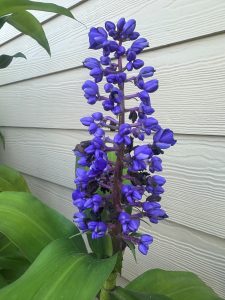
Blue Ginger flower spike. Photo courtesy of Daniel Leonard.
Adding to the appeal is that Blue Ginger is exceptionally easy to grow. However, the species does have specific growing condition needs. The ideal landscape placement for Blue Ginger is a shady oasis protected from the hot afternoon sun and blustery breeze that keeps its roots cool and moist and its succulent leaves from excessive drying. My specimen has performed excellently for over a decade on the north wall of an outbuilding, in relatively rich soil, mulched well to retain moisture, and shielded by a nearby fence. It has been years since I’ve either fertilized or watered it and the plant returns each summer, growing to about 4’ in height, and blooms each October, asking for nothing in return. One must remember the saying “Right Plant, Right Place”, as Blue Ginger can be the easiest plant ever to cultivate or a problem child that never performs like you want it to, all depending on where one sites it in the landscape.
If Blue Ginger has one drawback, it’s that it is uncommon in the nursery trade. When shopping for one, choose independent nurseries who are known to have a wide assortment of plants, maybe even a greenhouse/tropical section. I’ve never once seen Blue Ginger in a large chain nursery or box store. The best, cheapest, and most fun method of obtaining one though is to get a friend that has one to give you a cutting of their plant, as the stems root easily into new plants!
Think outside the box this fall and add some blue to your landscape with Blue Ginger. Give it a protected shady spot and a little water and it will reward your landscape with brilliant blues every October for years to come. For more information about Blue Ginger or any other horticultural topic, contact your local UF/IFAS County Extension office. Happy Gardening!
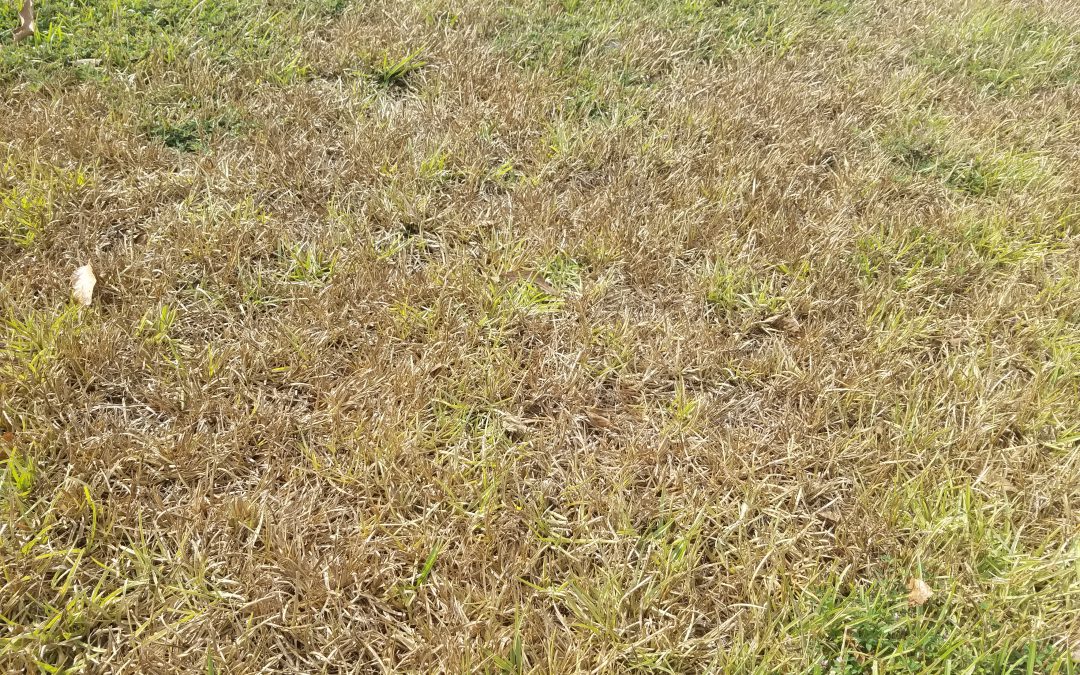
by Daniel J. Leonard | Sep 11, 2025
Many turfgrass yards, including mine, are feeling the effects of an extended droughty period this month. While one of the benefits of the primary turf species grown in the area (Centipedegrass, Zoysiagrass, Bermudagrass, and Bahiagrass), is their drought tolerant nature, they aren’t impervious to drought. Even with these tough grass species the difference between a yard coming out of a drought in decent shape versus dead is as simple as remembering the answers to the following four maintenance questions.
How much should I water to keep my grass alive?
Lawngrass needs about ¾-1” of water per week to remain looking its best and growing vigorously. Obviously, unless you have an irrigation system, keeping a large yard of turfgrass in that ideal water range is going to be hard or impossible. So, what to do? I encourage homeowners to focus their efforts on keeping grass around highly visible and often used areas of the yard well-watered, letting outlying areas fend for themselves until rain resumes. To ensure you’re putting out the optimal ¾-1” of irrigation per watering event, spread a few straight sided cans (tuna or cat food cans work great) under the sprinkler’s range, allow it to run until you reach the 1” mark, and note how long it took to apply that amount of water. This will help you dial in your watering and ensure water isn’t wasted.
Should I mow during a drought?
We all know that an unmown yard looks unkempt. However, given that mowing is a major stress on turfgrass, mowing during a drought can weaken your yard’s ability to recover when the drought ends. If you must mow to keep things looking neat, try to mow only areas that you keep watered and raise your mower’s deck to reduce the amount of leaf tissue you cut from the grass. Mowing in this manner will reduce stress on your turf and keep the yard from appearing weedy and unkempt. My unirrigated Centipedegrass yard has been flowering and setting seed over the last few weeks. My last mowing event (during the current dry period) was designed to only remove seedheads and minimize removal of leaf tissue.

Unirrigated Centipedegrass turf showing drought stress – photo courtesy of Daniel Leonard.
Should I fertilize?
This one is easy! Don’t fertilize grass during a drought! For one, fertilizer promotes growth, and grass isn’t trying to grow during a drought, simply survive. Fertilizing in these times is another unnecessary stress. Additionally, fertilizer requires water to transport nutrients down to the plant roots. If there is no water to do so, it will simply sit there and wait on rain. Also, some or all the nitrogen in the fertilizer applied will volatize and return to the atmosphere, wasting your time, money, and effort and stressing your turfgrass in the process. Hold the fertilizer until rain begins again.
What do I do about weeds?
Turfgrass isn’t the only thing stressed during droughts; weeds are as well. During stressful events like droughts, all plants (weeds included) stop growing and enter survival mode. This has major implications for weed control, as herbicides are not particularly effective on weeds with drought defenses up. In addition to being ineffective, herbicides can injure stressed turfgrass, preventing a healthy recovery post-drought. So, keep the herbicide off the yard until the weeds, and your turf, are happy and growing again.
Maintaining an unirrigated lawn during drought is more about what you don’t do – less mowing and no fertilizer or herbicide applications – than what you do. Mowing too low, applying fertilizer, and trying to control weeds with herbicide are all potential stressors of turf and can inhibit its recovery when the rain returns. The best you can do to keep your lawn healthy in dry times is to apply ¾-1” of water per week and pray for rain! For more information about lawn management or any other horticultural topic, contact your local UF/IFAS County Extension office.

by Daniel J. Leonard | Jul 31, 2025
All gardeners dream of the perfect plant that requires no maintenance, comes back every year, and remains strikingly beautiful nearly year-round. There is one such plant in my landscape that I never have to fuss over and always looks the part. One plant stands unflinching through summer heat or winter cold. One plant is never fazed by excessive rainfall or parching drought. One plant remains unbothered by pesky insects or disease. That plant is Purple Heart (Tradescantia pallida ‘Purpurea’) and it will always have a place in my garden.
Purple Heart is a tender perennial groundcover native to tropical Mexico and, as its name might imply, purple is the primary hue the species adds to landscapes. A true all-round performer, Purple Heart offers stunning purple foliage and small purplish-pink, pollinator-attracting flowers from spring green up to the first killing frost. In some mild winters, Purple Heart even behaves as an evergreen in the Panhandle!
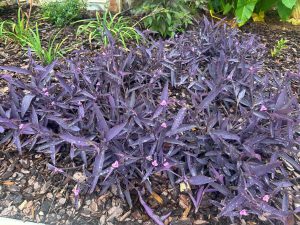
Purple Heart planting in July. Photo courtesy of Daniel Leonard.
Since attractive foliage is the primary draw with Purple Heart, siting it to maximize leaf color is important. For the deepest, most vivid shades of purple, plant in full sun; 6 or more hours of direct sunlight is ideal. Also, like many tropical plants, Purple Heart will look its best with ample moisture but, once established, is among the most drought tolerant options for Panhandle landscapes. I’ve found my Purple Heart stands look their best with occasional watering during extremely hot, dry periods, but other than that, they thrive on rainfall alone.
If there is a drawback to the species, it might be a little too vigorous and easy to grow. Because plantings can rapidly grow and expand, rooting along stems as it goes, Purple Heart can sometimes become weedy in landscapes. In my experience, Purple Heart plays nicely in the landscape with other perennials and isn’t aggressive to the point of choking out its neighbors. However, if you desire an extremely neat and orderly landscape, Purple Heart’s freewheeling nature might best be used as a spiller plant in large containers or planted in an area confined by hardscape features.
If you decide to color your landscape purple with Purple Heart, plants can be found for sale at nearly any garden center or nursery and are extremely easily propagated, making it a popular passalong plant – chances are you might know someone who would willingly share a cutting (or three) with you. For more information on this popular purple perennial or any other horticultural topic, contact your local UF/IFAS Extension county office. Happy gardening!











